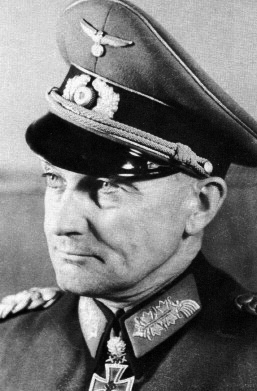Walther Model
Field Marshal Walther Model was a German army officer who served in Poland, Western Europe and the USSR during World War Two. During the war he gained a reputation for competence and efficiency.
Born in 1891, Walther Model joined the German Army in 1909 and served in World War One. He rapidly gained a reputation for good leadership and he stayed in the army after Germany’s defeat. By the outbreak of World War Two, Model was Chief-of-Staff to IV Corps. This Corps participated in the invasion of Poland. He became Chief-of-Staff to the 16th Army for the invasion of Western Europe.
During Operation Barbarossa - Germany’s invasion of the USSR-Model commanded the 3rd Panzer Division. This unit made rapid progress, leading the surge up to and past the River Dnieper. In light of these successes, Hitler promoted Model to commander of the XLI Panzer Corps with the rank of general. In January 1942, Model was given command of the 9th Army.

Model was considered an expert in ‘flexible defence’. He had no qualms about tactical withdrawal if it gifted his men time to re-organise and prepare for the next attack. However Hitler disdained the notion of tactical withdrawal; to him, it was redolent of cowardice. Hitler came into conflict with several other army generals over this issue.
Army Group North had faltered in its attempt to take Leningrad (St Petersburg). Hitler became convinced that Model was the man to turn around their fortunes; Model became commander of the Group in October 1943. He was further promoted to the rank of Field Marshal in March 1944.
Model then replaced Manstein as leader of Army Group South on 30 March 1944. In this role he demonstrated his ability to formulate successful defensive strategies. Model stymied the Soviet advance into Hungary via the Carpathians. In June 1944, Model was given command of Army Group Centre where he successfully held off the Red Army’s advance into Warsaw. Model’s position was challenging: he was always fighting a better-equipped army which had one common purpose.
On 14 August 1944, two months after the D-Day landings, Model was given command of the German army in Western Europe. The Allies now had hold of Normandy and could supply their armies well by air or boat across the channel. Bomber Command and the USAAF’s insistent bombing raids and French Resistance’s sabotaging of key communication routes made it difficult for the German army to match the Allies’ flow of supplies.
As commander of Army Group B, Model had to contend with the Allied landings at Arnhem. He also played a major part in the planning of the Ardennes Offensive, which resulted in the Battle of the Bulge. However, the German army was now fighting a losing battle. The advance of the Allies into Western Germany was unstoppable. Model’s army pulled back beyond the Ruhr and on 15 April 1945 he disbanded his army command.
On 12 April Walther Model committed suicide.
MLA Citation/Reference
"Walther Model". HistoryLearning.com. 2026. Web.
